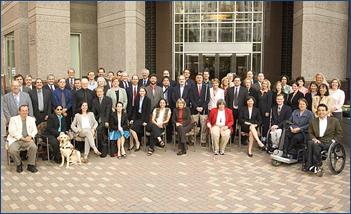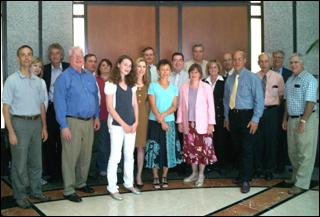
|
FY 2008
Annual Report
January 2009
Board Members
Introduction
A Change in Leadership
Guidelines and Standards
Outreach
Technical Assistance and Training
Enforcement of the ABA
Research
A FEDERAL AGENCY COMMITTED TO ACCESSIBLE DESIGN
U N I T E D S T A T E S A C C E S S B O A R D M E M B E R S
Public Members
| Douglas Anderson | Wheaton, Illinois |
| John Gunnar Box | Corona, California |
Joseph A. Cirillo, R.A. |
Middletown, Rhode Island |
| Ronald J. Gardner | Bountiful, Utah |
Edward H. Gee |
Stone Mountain, Georgia |
| James R. Harding II, Ed.D., | Tallahassee, Florida |
Phillip D. Jenkins |
Austin, Texas |
| Neil K. Melick | West Palm Beach, Florida |
Nancy Starnes |
Arlington, Virginia |
| Elizabeth A. Stewart | Winter Haven, Florida |
| Gary L. Talbot | Foxboro, Massachusetts |
Hans A. Van Winkle |
Lumberton, New Jersey |
John C. Wyvill |
Lincoln, Nebraska |
Federal Members
| Assistant Secretary for Administration | Department of Commerce |
| Principal Deputy Under Secretary of Defense for Personnel and Readiness | Department of Defense |
| Assistant Secretary for Special Education and Rehabilitative Services | Department of Education |
| General Counsel | Department of Health and Human Services |
| Assistant Secretary for Fair Housing and Equal Opportunity | Department of Housing and Urban Development |
| Assistant Secretary for Policy, Management and Budget | Department of Interior |
| Assistant Attorney General for Civil Rights | Department of Justice |
| Assistant Secretary of Labor for the Office of Disability Employment Policy | Department of Labor |
| Assistant Secretary for Transportation Policy | Department of Transportation |
| Assistant Secretary for Human Resources and Administration | Department of Veterans Affairs |
| Deputy Administrator | General Services Administration |
| Vice President, Facilities | United States Postal Service |
INTRODUCTION
The U.S. Access Board is an independent Federal agency that promotes equality for people with disabilities through leadership in accessible design. The Board develops guidelines and standards covering accessibility in the built environment, transportation, and information and communication technologies. Its design specifications play a critical role in fulfilling the promises of the Americans with Disabilities Act (ADA) and other Federal laws guaranteeing the rights of people with disabilities. In addition, the Board enforces accessibility standards covering federally funded facilities and promotes accessibility through public outreach, technical assistance, training, published guidance, and research.
FY 2008 was a year of both progress and change for the Access Board. The Board experienced a change in its leadership with the retirement of Lawrence W. Roffee, the Board's longtime executive director, and the selection of his successor. Through an active agenda developing and refreshing its guidelines and standards, the Board advanced work on a variety of rulemaking initiatives.
 |
 |
||
Lawrence Roffee |
David Capozzi |
In August, Lawrence Roffee retired after serving for two decades as the Board's executive director. During his tenure, Roffee oversaw considerable expansion of the Board's mission and services that began shortly after his arrival with passage of the ADA in 1990 and other laws. Roffee implemented programming measures and reforms enabling the Board to meet its growing responsibilities writing new guidelines and standards covering facilities in the private and public sectors, transportation vehicles, telecommunication, and information technology. He also spearheaded efforts to make the Board a leading resource on accessibility both nationally and abroad.
Following a competitive selection process, the Board named David M. Capozzi as its new executive director in early FY 2009. Capozzi joined the Board in 1992 as director of its Office of Technical and Information Services and served as acting executive director following Roffee's departure. "While we can be proud of all that the Board has accomplished over the years, there is much left to be done," Capozzi stated to the Board upon his selection. "I have a vision of a higher performing agency that will grow to meet the demands of our complex society, and I look forward to working with all of you to tackle some important issues in the coming years."
Issuing guidelines and standards and keeping them up to date constitute key responsibilities of the Board under the ADA and other laws. In FY 2008, the Board made progress on a review and update of its accessibility criteria for electronic and information technologies, telecommunications equipment, and transportation vehicles. The Board also continued work on new guidelines for outdoor environments, public rights-of-way, passenger vessels, and emergency transportable housing. Three advisory committees organized by the Board to advance these efforts concluded work and reported their findings to the Board.
 |
|
The committee's 41 members comprised a broad cross-section of stakeholders, including representatives from industry, disability groups, standard-setting bodies in the U.S. and abroad, and government agencies, among others. |
Information Technology and Telecommunications
Board standards issued under section 508 of the Rehabilitation Act address access to electronic and information technology procured by the Federal government, including computer hardware and software, websites, phone systems, fax machines, copiers, and other technologies. The Board also maintains guidelines for telecommunications products covered by section 255 of the Telecommunications Act. As the first step in a joint update of these guidelines and standards, the Board organized an advisory committee in 2006 to review the documents and to recommend changes. In April 2008, the Telecommunications and Electronic and Information Technology Advisory Committee completed its review and submitted a detailed report to the Board. The committee's report recommends changes to both the substance and the structure of the standards and guidelines and addresses a range of issues, including new or convergent technologies, market forces, compliance concerns, and international harmonization. Recognizing the importance of standardization across markets worldwide, the committee coordinated its work with other standard-setting bodies in the U.S. and abroad. The Board will propose updates to the guidelines and standards based on the committee's recommendations.
Transportation Vehicles
The Board also made progress on a review and update of its ADA guidelines for transportation vehicles which cover access to buses, vans, rail cars, and other modes of public transit. The Board refined a draft of updated guidelines for buses and vans based on input in received from the public in response to an earlier draft released the year before. Vehicle manufacturers, transit operators, trade associations, consumers, disability groups, and others provided feedback on the initial draft and information responsive to questions posed by the Board. This input was used to improve updated provisions, including those addressing level boarding access, automated stop announcement systems, boarding devices, wheelchair spaces, headrests, and accessible routes. The Board made the revised draft available for comment in late 2008. The Board will later update specifications for rail cars and other vehicles covered by the guidelines.
 |
|
The Passenger Vessel Emergency Alarms Advisory Committee's 13 members included representatives from disability organizations, the vessel and cruise ship industry and trade groups, and the National Fire Protection Association. |
Passenger Vessels
The Board is developing new guidelines, the first of their kind, addressing access to passenger vessels, including cruise ships, ferries, and excursion boats. Through drafts of the guidelines previously released to the public for input, the Board identified areas where further information is needed in this effort. One such area, access to emergency alarm systems for passengers with hearing impairments, was investigated through an advisory committee organized by the Board in 2007. The Passenger Vessel Emergency Alarms Advisory Committee reviewed current emergency notification and safety practices, protocols, and standards adopted by the U.S. Coast Guard, international authorities, and other countries. The committee concluded its work in 2008 and submitted a report to the Board. The committee's report outlines consensus recommendations on access to vessel alarm systems in public use areas and to those located in passenger cabins. The Board will incorporate the committee's recommendations into the vessel guidelines which will be issued in proposed form for public comment.
Outdoor Developed Areas
The Board also made progress on new guidelines that will address access to outdoor developed areas, including parks, camp sites, trails, and beaches. How, and to what extent, access can be achieved in these types of environments has long been a source of confusion due to challenges and constraints posed by terrain, the degree of development, construction practices and materials, and other factors. Guidelines being developed by the Board will clarify where compliance is required and detail how access can be achieved. In 2008, the Board worked to finalize guidelines that specifically cover outdoor sites managed by the Federal government. The guidelines were made available for public comment the year before. As part of this effort, the Board held an information meeting in June to collect additional input on beach access routes. The Board plans to follow-up this effort with similar guidelines for non-federal sites.
Public Rights-of-Way
Public streets and sidewalks present unique access challenges that are not specifically addressed by existing guidelines or standards. Access at street crossings for pedestrians with vision impairments, on-street parking, and constraints posed by terrain and space limitations are just some of the issues that often arise. The Board is developing guidelines for public rights-of-way that will address these and other issues so that practitioners have an established reference for achieving accessible streets and sidewalks. In FY 2008, the Board continued work on a proposed set of guidelines that incorporates feedback from the public received in response to previously released drafts. The Board also has maintained an active outreach and training program on rights-of-way access to advance this rulemaking and to provide interim guidance until the guidelines are completed. Throughout the year, the Board conducted training sessions on the subject at different venues across the country, routinely advised state and local jurisdictions on planning and program strategies, coordinated its work with other agencies and stakeholder groups, and promoted supportive research.
Emergency Transportable Housing
Another way the Board provides leadership in accessible design is by being responsive to issue areas and trouble spots as they arise. One such area, access to temporary housing provided by the government in emergencies and natural disasters, came to light in the wake of Hurricane Katrina. The Board began an examination of the issue in 2006 not long after problems were first reported, coordinating its work with other agencies, including FEMA and the Department of Housing and Urban Development. Based on this initial exploration, the Board established an advisory committee the following year to develop recommendations on resolving access barriers in emergency transportable housing units. The Emergency Transportable Housing Advisory Committee included representatives from disability groups, industry and code groups, and government agencies. Committee members assessed design factors and constraints, including size and space limitations, against relevant accessibility specifications in the Board's facility guidelines. In 2008, the committee concluded its deliberations and submitted its report to the Board. The committee's report provides recommendations on how potential conflicts can be mediated and access to units can be improved. The report details suggested revisions to the Board's guidelines tailored to these types of units.
As part of its efforts to reach out to various audiences and to promote greater access, the Board regularly undertakes activities focused on a topic where access is known to be problematic. In 2008, the Board undertook a new initiative focused on access to airports. In addition, each year the Board holds a town meeting in a different city to hear from individuals on issues of concern and to update the public on its work. These events offer an open dialogue on accessible design and typically include presentations and briefings on specific topics. The Board held its 2008 town meeting in St. Louis.
Airport Accessibility
The Board chose to highlight airport accessibility as a focus topic since it is the subject of many access issues and complaints. Consumer surveys indicate that over 80% of travelers with disabilities report access problems or barriers at airports. In 2008, the Board began an exploration of common access problems at airports and potential solutions and improvements in order to improve compliance and to promote effective design. At several of its meetings over the course of the year, invited speakers briefed the Board on a range of topics, including ticketing kiosks, communications, security screening, boarding bridges, research, and consumer surveys. Work on this topic will continue in 2009.
St. Louis Town Meeting
In May, the Board held its annual town meeting in St. Louis at the America's Center in conjunction with the Great Plains ADA Center's National ADA Symposium. The event provided a forum for members of the public to advise the Board on issues of concern to them and to ask questions about accessibility or the work of the Board. The Board heard concerns expressed about air travel and access at airports and aboard planes, and questions and recommendations on other topics as addressed in the Board's guidelines. In addition to the town meeting, the Board also conducted a series of break-out sessions at the Symposium covering public rights-of-way, recreation facilities, bathroom access, the ADA guidelines and the International Building Code, and information technology and e-government. The sessions provided an opportunity for the Board to address in greater depth many of the technical questions raised in the town meeting.
While in St. Louis, the Board toured Busch Stadium and received a briefing by designers from HOK Sport on how accessibility was integrated into its design. Board members also visited the Central Institute for the Deaf to examine firsthand its pioneering work on quiet classrooms, which are designed to promote good acoustics for quality learning environments. During the visit, audiologists and acoustical designers briefed the Board on efforts to promote implementation of acoustical standards developed for classrooms.
TECHNICAL ASSISTANCE AND TRAINING
Through its work developing guidelines and standards, the Board is uniquely qualified to provide technical guidance and training on accessible design to a wide range of audiences, including designers and architects, industry, advocacy groups, and others. The Board also publishes guides and other resources to supplement the one-on-one guidance it offers daily through its technical assistance line. These services and publications play a critical role in assisting various professionals understand and apply accessibility requirements.
Technical Assistance
In following the Board's design criteria, questions arise on the best way to achieve accessibility or what compliance with a particular requirement means in light of various real world conditions. The Board provides answers to these questions and guidance on accessible design through its toll-free technical assistance line. It also responds to technical inquiries submitted by email and fax. Guidance is available on all Board guidelines and standards, including those covering the built environment, vehicle design, or information and telecommunication technology. Assistance is also available on topics to be addressed by future guidelines, such as outdoor environments, public rights-of-ways, and passenger vessels. This individualized guidance improves compliance and helps ensure that access is achieved properly. Last year, the Board handled over 13,200 technical inquiries.
Training
The Board regularly provides training on accessible design to various audiences at different conferences and events across the country. Most training pertains to design criteria for facilities, transportation vehicles, and information technology. Training sessions, which are targeted to the needs and interests of each audience, attract designers and architects, code officials, advocacy groups, transportation operators, the information technology industry, and other professionals in assorted fields. In 2008, the Board conducted 91 sessions and provided training to over 7,500 people.
Resources
To supplement its guidelines and standards, the Board produces and distributes an array of guidance materials, including user-friendly companion guides, technical bulletins, manuals, and online courses. These and other materials are available on the Board's website, www.access-board.gov, which has become a popular resource on accessible design. In 2008, the Board's site logged over 42.8 million hits and more than 3 million unique user sessions. The Board also continues to distribute its materials by mail upon request and sent out over 6,100 copies of its publications last year.
Last year marked the 40th anniversary of the Architectural Barriers Act (ABA), one of the first laws on the books requiring access to the built environment. Unanimously passed by Congress in 1968, the ABA made accessibility a condition of Federal funding in construction, alterations, and leasing. The ABA covers a wide range of government buildings, including post offices, social security offices, and Federal office buildings. It also applies to non-Federal buildings that are federally funded, such as schools, transit stations, local courthouses and jails, and public housing. Though limited in scope, the ABA laid the foundation for later laws more encompassing in reach. These include the Rehabilitation Act of 1973, which covers access to programs and services funded by the government and Federal employment, and the ADA, which requires access and prohibits discrimination based on disability throughout the private and public sectors without regard to Federal funding.
Initially, the ABA left compliance up to each Federal agency with little guidance or support. At the time, accessible design was a new concept and few standards or resources were available. To address these shortcomings, Congress created the Access Board several years later through passage of the Rehabilitation Act. The Board was charged with developing minimum guidelines for accessible design, providing technical assistance, and enforcing the ABA's design standards, responsibilities it maintains to this day. The Board enforces ABA compliance through the investigation of complaints. In its investigations, the Board determines whether a facility is covered by the ABA and, if so, whether it meets the applicable design standards. If a covered facility is not in compliance, the Board will pursue a corrective action plan and monitor the case until all necessary work is completed. In 2008, the Board opened or advanced 184 investigations and closed 70 cases. Barriers were successfully remedied in all cases where the law applied, and in some cases voluntarily where it did not.
The Board conducts a research program to support the development of guidelines, standards, and guidance material and to promote accessible design. Each year, the Board initiates a variety of projects, often in partnership with other organizations. Most projects focus on the study of accessibility in relation to architecture and design, human factors, communication, and transportation. Board projects underway last year include research on play surfaces, trail surfaces, the effects of surfaces and slope on wheelchair travel, and wheelchair transfer. The Board also supported or broadened research efforts undertaken by others, including a major project unprecedented in scope to collect human measures of people who use manual wheelchairs and motorized devices and a study on wayfinding cues used by pedestrians with vision impairments. Several other Board projects will develop needed guidance on various topics, including construction tolerances, point-of-sale machines, museum exhibit design, pedestrian signals, and state code implementation and enforcement.